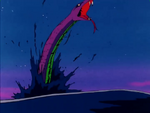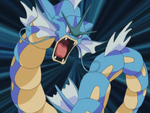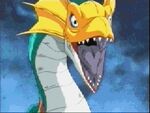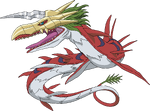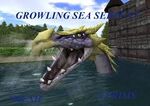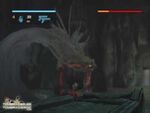Sea Serpent is a broad, general category of sea monster. The term can be applied to any mythic or legendary marine creature that is large and vaguely serpentine-shaped.
Sea Serpents and the Chaoskampf Trope[]
Sea serpents are closely associated with the mythological trope of the Chaoskampf, where a storm god representing order battles a primordial sea god representing chaos. This primordial sea god, which often takes the form of a serpent or dragon, is eventually defeated and killed by the storm god in order to create the world.
Babylonian Mythology[]

A Neo-Assyrian cylindrical seal that depicts a serpentine creature that may be Tiamat (900-750 BCE)
The Babylonian creation myth, known as the Enuma Elish, tells of the goddess Tiamat, the personification of the primordial chaos prior to creation, represented by a churning sea of salt water. Originally Tiamat is described as a monstrous griffin-like monster, but in later depictions Tiamat is shown in the form of a primeval serpent. In the Enuma Elish Tiamat gives birth to the first generation of gods in the Babylonian pantheon after mingling with her partner Apsu, the god of fresh waters.
Eventually, Apsu begins to argue with this first generation of gods over the loud noises they make, which escalates to an altercation that leads to Apsu being killed by the gods. In response, Tiamat gives birth to many demons in an attempt to destroy the gods. This leads to the storm god Marduk battling with Tiamat, where he eventually slays her with the help of this wind:
| “ | 93 Tia-mat and Marduk, the sage of the gods, came together, 94 Joining in strife, drawing near to battle. 95 Be-l spread out his net and enmeshed her; 96 He let loose the Evil Wind, the rear guard, in her face. 97 Tia-mat opened her mouth to swallow it, 98 She let the Evil Wind in so that she could not close her lips. 99 The fierce winds weighed down her belly, 100 Her inwards were distended and she opened her mouth wide. 101 He let fly an arrow and pierced her belly, 102 He tore open her entrails and slit her inwards, 103 He bound her and extinguished her life, 104 He threw down her corpse and stood on it.[1] |
” |
After defeating Tiamat, Marduk then divides her corpse, using the pieces of her body to form creation:
| “ | 1 He fashioned heavenly stations for the great gods, 2 And set up constellations, the patterns of the stars. 3 He appointed the year, marked off divisions, 4 And set up three stars each for the twelve months. 5 After he had organized the year, 6 He established the heavenly station of Ne-beru to fix the stars' intervals. 7 That none should transgress or be slothful 8 He fixed the heavenly stations of Enlil and Ea with it. 9 Gates he opened on both sides, 10 And put strong bolts at the left and the right. 11 He placed the heights (of heaven) in her (Tia-mat's) belly, 12 He created Nannar, entrusting to him the night. 13 He appointed him as the jewel of the night to fix the days, 14 And month by month without ceasing he elevated him with a crown, 15 (Saying,) "Shine over the land at the beginning of the month, 16 Resplendent with horns to fix six days. 17 On the seventh day the crown will be half size, 18 On the fifteenth day, halfway through each month, stand in opposition. 19 When Šamaš [sees] you on the horizon, 20 Diminish in the proper stages and shine backwards. 21 On the 29th day, draw near to the path of Šamaš, 22 . [ . . ] the 30th day, stand in conjunction and rival Šamaš. 23 I have ( . . . . ] . the sign, follow its track, 24 Draw near . . ( . . . . . ) give judgment. 25 . [ . . . . ] . Šamaš, constrain [murder] and violence, 26 . [ . . . . . . . . . . . . . . . . . . . ] . me.[2] |
” |
Jewish Mythology[]

A depiction of the creation of birds and fish, including a sea serpent, by Gustave Doré for John Milton's Paradise Lost (c. 1868)
It is generally believed that the creation account in the first chapter of Genesis in the Hebrew Bible was inspired in part by the Enuma Elish. In the creation account, God is shown to be hovering above the chaotic waters with his רוּחַ ("rû́aḥ ," literally: "spirit, breath, wind"), evoking storm god imagery. Being a monotheistic faith, at no point in Genesis is the chaotic waters shown to have it's own agency, emphasizing God's total unchallenged dominion over creation:
| “ | 1 When God began to create the heavens and the earth, 2 the earth was complete chaos, and darkness covered the face of the deep, while a wind from God swept over the face of the waters. 3 Then God said, “Let there be light,” and there was light. 4 And God saw that the light was good, and God separated the light from the darkness. 5 God called the light Day, and the darkness he called Night. And there was evening and there was morning, the first day. | ” |
| “ | 6 And God said, “Let there be a dome in the midst of the waters, and let it separate the waters from the waters.” 7 So God made the dome and separated the waters that were under the dome from the waters that were above the dome. And it was so. 8 God called the dome Sky. And there was evening and there was morning, the second day. | ” |
| “ | 9 And God said, “Let the waters under the sky be gathered together into one place, and let the dry land appear.” And it was so. 10 God called the dry land Earth, and the waters that were gathered together he called Seas. And God saw that it was good. 11 Then God said, “Let the earth put forth vegetation: plants yielding seed and fruit trees of every kind on earth that bear fruit with the seed in it.” And it was so. 12 The earth brought forth vegetation: plants yielding seed of every kind and trees of every kind bearing fruit with the seed in it. And God saw that it was good. 13 And there was evening and there was morning, the third day.[3] | ” |
Later, in Genesis 1:21, God is shown to create תַּנִּינִים ("tanninim," literally: "serpents, dragons, sea monsters," though commonly translated as "whales," or "creatures of the sea"), downgrading the status of primordial sea serpents such as Tiamat from the level of gods to the level of created beings:
| “ | 20 And God said, “Let the water teem with living creatures, and let birds fly above the earth across the vault of the sky.” 21 So God created the great creatures of the sea and every living thing with which the water teems and that moves about in it, according to their kinds, and every winged bird according to its kind. And God saw that it was good. 22 God blessed them and said, “Be fruitful and increase in number and fill the water in the seas, and let the birds increase on the earth.” 23 And there was evening, and there was morning—the fifth day.[4] | ” |
Rahab[]
In spite of Genesis' treatment of the watery chaos and sea serpents, in other parts of the Hebrew Bible there are references that clearly refer to God as battling with a chaotic serpent in a manner similar to Marduk's battle with Tiamat. In these references the serpent in question is referred to as "Rahab," meaning "blusterer, arrogance, noise, tumult," referencing the noise of the churning sea. It is thought that Rahab may be an alternate term for Tiamat herself:
| “ | 12 By his power he stilled the Sea; by his understanding he struck down Rahab. 13 By his wind the heavens were made fair; his hand pierced the fleeing serpent.[5] |
” |
In the Hebrew Bible Rahab is also used as a poetic name for Egypt, and in Talmudic literature Rahab became the name of a demon.
Leviathan[]
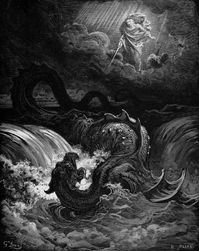
Destruction of Leviathan by Gustave Doré, depicting the moment before the Leviathan is destroyed by God at the end of days. (c. 1865)
A second sea serpent mentioned in the Hebrew Bible is the Leviathan. Like the Rahab, Leviathan can be found in the Book of Job, though featured much more prominently. Unlike the Rahab, the Leviathan is depicted as one of God's creations and God's pet, as opposed to an adversary. In this way the Leviathan is analogous to the sea serpents created by God in the Book of Genesis. In the Book of Job, God shows Job the Leviathan, the greatest and most powerful of all his creations, in order to demonstrate how unimaginably powerful he is in having created such a being:
| “ | 1 “Can you draw out Leviathan with a fishhook or press down its tongue with a cord? 2 Can you put a rope in its nose or pierce its jaw with a hook? 3 Will it make many supplications to you? Will it speak soft words to you? 4 Will it make a covenant with you to be taken as your servant forever? 5 Will you play with it as with a bird or put it on a leash for your young women? 6 Will traders bargain over it? Will they divide it up among the merchants? 7 Can you fill its skin with harpoons or its head with fishing spears? 8 Lay hands on it; think of the battle; you will not do it again! 9 Any hope of capturing it will be disappointed; one is overwhelmed even at the sight of it. 10 No one is so fierce as to dare to stir it up. Who can stand before it? 11 Who can confront it and be safe? —under the whole heaven, who?[6] |
” |
The text then goes into detail with the Leviathan's description, describing it as a ferocious fire-breathing water dragon with impenetrable armor:
| “ | 12 “I will not keep silent concerning its limbs or its mighty strength or its splendid frame. 13 Who can strip off its outer garment? Who can penetrate its double coat of mail? 14 Who can open the doors of its face? There is terror all around its teeth. 15 Its back is made of shields in rows, shut up closely as with a seal. 16 One is so near to another that no air can come between them. 17 They are joined one to another; they clasp each other and cannot be separated. 18 Its sneezes flash forth light, and its eyes are like the eyelids of the dawn. 19 From its mouth go flaming torches; sparks of fire leap out. 20 Out of its nostrils comes smoke, as from a boiling pot and burning rushes. 21 Its breath kindles coals, and a flame comes out of its mouth. 22 In its neck abides strength, and terror dances before it. 23 The folds of its flesh cling together; it is firmly cast and immovable. 24 Its heart is as hard as stone, as hard as the lower millstone. 25 When it raises itself up the gods are afraid; at the crashing they are beside themselves. 26 Though the sword reaches it, it does not avail, nor does the spear, the dart, or the javelin. 27 It counts iron as straw and bronze as rotten wood. 28 The arrow cannot make it flee; slingstones, for it, are turned to chaff. 29 Clubs are counted as chaff; it laughs at the rattle of javelins. 30 Its underparts are like sharp potsherds; it spreads itself like a threshing sledge on the mire. 31 It makes the deep boil like a pot; it makes the sea like a pot of ointment. 32 It leaves a shining wake behind it; one would think the deep to be white-haired. 33 On earth it has no equal, a creature without fear. 34 It surveys everything that is lofty; it is king over all that are proud.”[7] |
” |
Norse Mythology[]
In Norse mythology, Jǫrmungandr, or "Miðgarðsormr" was a sea serpent so long that it encircled the entire world, Miðgarðr. Some stories report of sailors mistaking its back for a chain of islands. Sea serpents also appear frequently in later Scandinavian folklore, particularly in that of Norway.
Japanese Mythology[]

The Yamata No Orochi
In Japanese mythology, Yamata no Orochi is a gigantic serpent with eight heads and eight tails. It has bright red eyes and a red belly. The beast is so large that its body covers the distance of eight valleys and eight hills. Fir and cypress trees grow on its back, and its body is covered in moss.
Yamata no Orochi appears in the earliest written Japanese documents, the Kojiki and the Nihongi. The legend goes back even farther into pre-history.
Sea Serpents in Traveler's Tales[]
Sea serpents are also a common feature of traveler's tales, where they are typically found in exotic and foreign locations, and are often depicted attacking ships. Traveler's tales involving ship-attacking sea serpents can be found in ancient Greece and Scandinavia, but were most common during the European Age of Exploration, when Europe began to explore the seas for new trade routes.
In 1028 AD, Saint Olaf is said to have killed a sea serpent in Valldal, Norway, throwing its body onto the mountain Syltefjellet. Marks on the mountain are associated with the legend. In Swedish ecclesiastic and writer Olaus Magnus's Carta marina, many marine monsters of varied form, including an immense sea serpent, appear. Moreover, in his 1555 work History of the Northern Peoples, Magnus gives the following description of a Norwegian sea serpent:
| “ | Those who sail up along the coast of Norway to trade or to fish, all tell the remarkable story of how a serpent of fearsome size, 200 feet long and 20 feet wide, resides in rifts and caves outside Bergen. On bright summer nights this serpent leaves the caves to eat calves, lambs and pigs, or it fares out to the sea and feeds on sea nettles, crabs and similar marine animals. It has ell-long hair hanging from its neck, sharp black scales and flaming red eyes. It attacks vessels, grabs and swallows people, as it lifts itself up like a column from the water. | ” |
Maritime Folklore[]
Hans Egede, the national saint of Greenland, gives an 18th century descriptions of a sea serpent. On 6 July 1734 his ship sailed past the coast of Greenland when suddenly those on board
| “ | saw a most terrible creature, resembling nothing they saw before. The monster lifted its head so high that it seemed to be higher than the crow's nest on the mainmast. The head was small and the body short and wrinkled. The unknown creature was using giant fins which propelled it through the water. Later the sailors saw its tail as well. The monster was longer than our whole ship | ” |
Sea serpent legends are common off of the North American Atlantic coast, particularly around New England and the waters between Bermuda and adjacent American islands (known as the Graveyard of the Atlantic), with documentation beginning in 1638.
- An incident in August 1817 spawned a rather silly mix-up when a committee of the New England Linnaean Society went so far as to give a deformed terrestrial snake the name Scoliophis atlanticus, believing it was the juvenile form of a sea serpent that had recently been reported in Gloucester Harbor. The Gloucester Harbor serpent was claimed to have been seen by hundreds of New England residents, including the crews of four whaling boats that reportedly sought out the serpent in the harbor. Rife with political undertones, the serpent was known in the harbor region as "Embargo." Sworn statements made before a local Justice of the Peace and first published in 1818.
- The waters between Bermuda and the Outer Banks were commonly associated with Sea Serpents by Norwegian mariners. The serpents were believed to have large fangs and long, eel-like bodies.
Sea Serpents in Cryptozoology[]
In more contemporary times, tales of sea serpents can be found within the pseudoscience of cryptozoology, where a combination of misidentifications, hoaxes, and appropriated local and indigenous tales has lead some to believe that sea serpents still haunt particular locations.
Gallery[]
Historical Depictions[]
Films[]
Animations[]
Video games[]
References[]
- ↑ -Enuma Elish, Tablet IV 93-104 https://www.worldhistory.org/article/225/enuma-elish---the-babylonian-epic-of-creation---fu/
- ↑ -Enuma Elish, Tablet V 1-26 https://www.worldhistory.org/article/225/enuma-elish---the-babylonian-epic-of-creation---fu/
- ↑ -Genesis 1:1-13 (NRSVUE) https://www.biblegateway.com/passage/?search=Genesis+1&version=NRSVUE
- ↑ -Genesis 1:20-23 (NRSVUE) https://www.biblegateway.com/passage/?search=Genesis+1&version=NRSVUE
- ↑ -Job 26:12-13 (NRSVUE) https://www.biblegateway.com/passage/?search=job+26&version=NRSVUE
- ↑ -Job 41:1-11 (NRSVUE) https://www.biblegateway.com/passage/?search=job+41&version=NRSVUE
- ↑ -Job 41:12-34 (NRSVUE) https://www.biblegateway.com/passage/?search=job+41&version=NRSVUE
| Maritime folklore | |
|---|---|
| Legendary Sailors & Pirates | Blackbeard • Black Caesar • Jason • Sinbad the Sailor |
| Sea Monsters | Akheilos • Akhlut • Akkorokamui • Angeoa • Bahamut • Bakunawa • Bunyip • Cetus • Charybdis • Golden Clip Crayfish • Ḫedammu • Imap Umassoursua • Isonade • Jǫrmungandr • Keto-Esu • Kraken • Leviathan • Loch Ness Monster • Nuckelavee • Păl Raí Yûk • Porpoise people • Qaxdascidi • Quinotaur • Sazae-oni • Scylla • Sea lion • Sea serpent • Shiofuki • Stoor worm • Ugjuknarpak • Yamata no Orochi |
| Mermaids | Amabie • Anola • Ceasg • Chernava • Iara • Lamia • Nereid • Sirena • Sirenuca • Yawkyawk |
| Ghost Ships | El Caleuche • Fireship of Baie des Chaleurs • Flying Dutchman • Palatine Light • Phantom Canoe of Lake Rotomahana |
| Locations | Bermuda Triangle • Costa da Morte • Devil's Sea • Graveyard of the Atlantic • Graveyard of the Pacific • Libertatia • Terra Australis |
| Other | Moby-Dick • The Rime of the Ancient Mariner |









